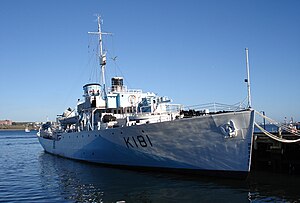HMCS Sackville (K181)

HMCS Sackville in October 2006, moored alongside the Maritime Museum of the Atlantic in Halifax, Nova Scotia and restored to her 1944 condition.
|
|
| History | |
|---|---|
|
|
|
| Name: | Sackville |
| Namesake: | Sackville, New Brunswick |
| Builder: | Saint John Dry Dock and Shipbuilding Company Ltd. |
| Laid down: | 28 May 1940 |
| Launched: | 15 May 1941 |
| Commissioned: | 30 December 1941 |
| Decommissioned: | 8 April 1946 |
| Refit: |
Thompson Bros. Machinery Co. Ltd., Liverpool, Nova Scotia, commenced 14 January 1943, machinery replacement, minesweeping gear removed, bridge wings extended to fit Oerlikon 20 mm AA Galveston, Texas, 28 February 1944-7 May 1944, forecastle extended, new bridge, hedgehog fitted, mast moved abaft of bridge, new boats, new electronics |
| Identification: | Pennant number: K181 |
| Honours and awards: |
Atlantic 1942-44 |
| Fate: | Museum ship, Halifax, Nova Scotia |
| General characteristics | |
| Class and type: | Flower-class corvette |
| Displacement: | 950 tons |
| Length: | 62.5 m (205 ft 1 in) |
| Beam: | 10 m (32 ft 10 in) |
| Draught: | 3.5 m (11 ft 6 in) |
| Propulsion: | Single shaft, 2 fire tube Scotch boilers, 1 4-cyl. triple expansion steam engine, 2,750 hp (2,050 kW) |
| Speed: | 16 knots (30 km/h; 18 mph) |
| Complement: | 85 |
| Armament: |
|
| Notes: | Now a museum ship owned by the Canadian Naval Memorial Trust, moored in season at the Maritime Museum of the Atlantic |
| Official name | HMCS Sackville National Historic Site of Canada |
| Designated | 1988 |
Thompson Bros. Machinery Co. Ltd., Liverpool, Nova Scotia, commenced 14 January 1943, machinery replacement, minesweeping gear removed, bridge wings extended to fit Oerlikon 20 mm AA
HMCS Sackville is a Flower-class corvette that served in the Royal Canadian Navy and later served as a civilian research vessel. She is now a museum ship located in Halifax, Nova Scotia and the last surviving Flower-class corvette.
Sackville's keel was laid down as Patrol Vessel 2 at the Saint John Shipbuilding and Drydock Company of Saint John, New Brunswick in early 1940, the second of the Flower-class corvettes ordered by the Royal Canadian Navy. She was launched on 15 May 1941 by Mrs. J. E. W. Oland, wife of the captain of the port, with the Mayor and entire town council of her namesake town in attendance.Sackville was commissioned into the Royal Canadian Navy on 30 December 1941 by Captain J. E. W. Oland, husband of the ship's sponsor. Her first commanding officer, Lieutenant W. R. Kirkland, RCNR was appointed on 30 December but did not join Sackville until 2 January. Kirkland was discharged in March 1942 as "unsuitable" after a poor working-up trip to Newfoundland in late February. The first lieutenant reported that Kirkland had been unable to discharge his duties and had been abusive to his officers. After rescuing the survivors from the sunken Greek ship Lily, Sackville was unable to re-locate her convoy, ONS 68. The first lieutenant then took the step of relieving Kirkland and assuming command. The original crew was reposted to other RCN ships and the already trained crew of HMCS Baddeck under Lieutenant-Commander Alan H. Easton, RCNR was drafted onto the ship on 6 April 1942. Also in April Sackville received Canadian-built SW1C radar and worked up at Halifax and St. Margarets Bay.
...
Wikipedia
